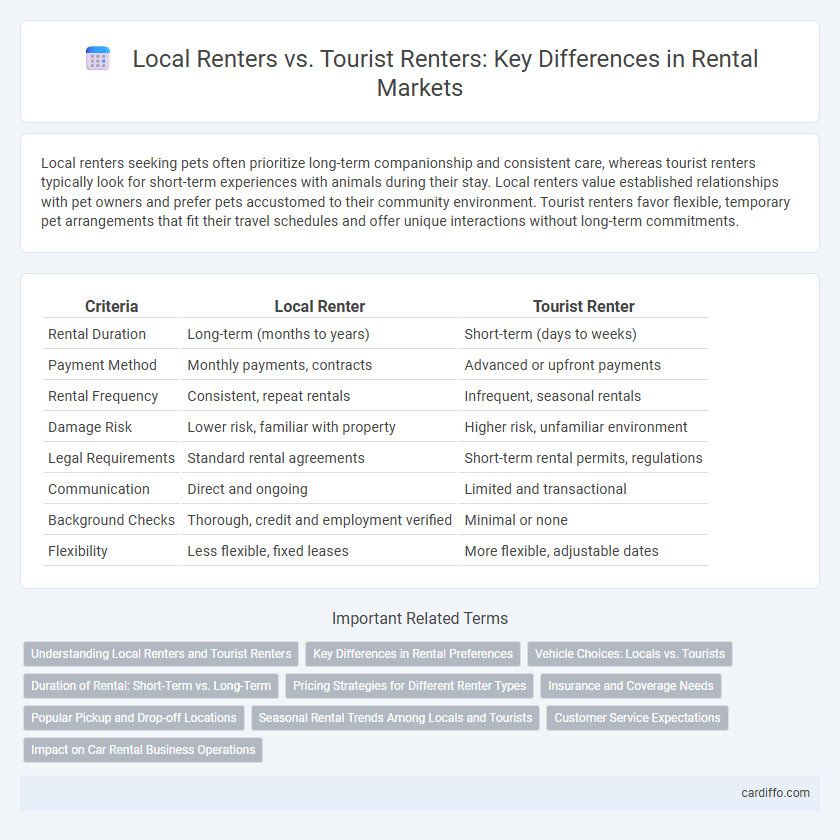Local renters seeking pets often prioritize long-term companionship and consistent care, whereas tourist renters typically look for short-term experiences with animals during their stay. Local renters value established relationships with pet owners and prefer pets accustomed to their community environment. Tourist renters favor flexible, temporary pet arrangements that fit their travel schedules and offer unique interactions without long-term commitments.
Table of Comparison
| Criteria | Local Renter | Tourist Renter |
|---|---|---|
| Rental Duration | Long-term (months to years) | Short-term (days to weeks) |
| Payment Method | Monthly payments, contracts | Advanced or upfront payments |
| Rental Frequency | Consistent, repeat rentals | Infrequent, seasonal rentals |
| Damage Risk | Lower risk, familiar with property | Higher risk, unfamiliar environment |
| Legal Requirements | Standard rental agreements | Short-term rental permits, regulations |
| Communication | Direct and ongoing | Limited and transactional |
| Background Checks | Thorough, credit and employment verified | Minimal or none |
| Flexibility | Less flexible, fixed leases | More flexible, adjustable dates |
Understanding Local Renters and Tourist Renters
Local renters typically seek long-term rental agreements prioritizing convenience, affordability, and proximity to workplaces or schools, which influences the demand for stable and furnished properties. Tourist renters prefer short-term rentals emphasizing amenities, flexible booking, and prime locations near attractions, resulting in higher turnover rates and seasonal fluctuations. Understanding these distinct preferences helps landlords optimize rental strategies and tailor marketing approaches effectively.
Key Differences in Rental Preferences
Local renters prioritize long-term leases and cost-effective properties close to work or schools, valuing community amenities and stable rental agreements. Tourist renters seek short-term rentals with flexible booking options, amenities catering to convenience and entertainment, and locations near popular attractions or transit. The rental market adapts to these distinctions by offering diverse property types and lease terms tailored to each renter's unique needs and duration of stay.
Vehicle Choices: Locals vs. Tourists
Local renters often prefer fuel-efficient and compact vehicles that suit daily commuting and urban driving, emphasizing practicality and cost-effectiveness. Tourist renters typically choose SUVs, convertibles, or larger cars that enhance comfort and sightseeing experiences during vacation. Vehicle rental companies tailor their fleets to reflect these preferences, optimizing inventory for both local convenience and tourist appeal.
Duration of Rental: Short-Term vs. Long-Term
Local renters typically prefer long-term rental agreements, seeking stability and consistent housing over several months or years, whereas tourist renters usually opt for short-term rentals lasting from a few days to weeks. Short-term rentals cater to tourists' flexible travel plans and transient stays, often equipped with amenities suited for temporary comfort and convenience. Property owners balance pricing strategies and lease terms to accommodate these varying rental durations and maximize occupancy rates.
Pricing Strategies for Different Renter Types
Local renters prefer long-term leases with steady, discounted monthly rates, while tourist renters are targeted with premium pricing for short-term stays. Dynamic pricing models adjust rates based on seasonality, demand, and length of stay, maximizing revenue from tourists during peak seasons. Offering flexible payment plans and loyalty discounts can enhance attraction and retention for both local and tourist renters.
Insurance and Coverage Needs
Local renters typically require insurance policies that cover personal liability and property damage for long-term or frequent use, ensuring protection against household incidents. Tourist renters prioritize coverage that includes short-term travel-related risks such as trip cancellations, theft, and temporary accommodation liabilities. Understanding distinct insurance needs helps rental companies tailor coverage options, enhancing security and satisfaction for both renter types.
Popular Pickup and Drop-off Locations
Popular pickup and drop-off locations for local renters typically include urban centers and suburban areas near residential neighborhoods, offering convenient access for daily or weekly rentals. Tourist renters prefer high-traffic spots such as airports, hotels, and major tourist attractions, facilitating seamless travel experiences. Analyzing data from rental services reveals that airport terminals and downtown hubs consistently rank as the most frequented locations for both local and tourist rentals.
Seasonal Rental Trends Among Locals and Tourists
Seasonal rental trends reveal that local renters typically seek long-term leases during off-peak seasons, prioritizing stability and community integration, while tourist renters drive high demand for short-term rentals in peak travel months, particularly summer and holidays. Data from vacation hotspots indicates a sharp increase in tourist rental bookings between June and August, coinciding with school vacations and favorable weather conditions. Local renter activity, however, peaks during academic semesters and declines when tourists dominate the market, influencing rental prices and availability.
Customer Service Expectations
Local renters typically expect personalized customer service with quick response times and flexible leasing options tailored to long-term needs. Tourist renters prioritize efficient check-in/out processes, clear information about amenities, and prompt resolution of short-term stay issues. Both groups demand transparent communication and reliable support but differ in the duration and type of assistance required.
Impact on Car Rental Business Operations
Local renters often generate consistent demand for car rental businesses, providing stable revenue streams and enabling better fleet management based on predictable usage patterns. Tourist renters typically create seasonal spikes in rentals, requiring flexible inventory strategies and intensified marketing efforts to capture short-term demand surges. Balancing the operational needs of local and tourist renters is crucial for optimizing fleet utilization, pricing models, and customer service protocols in car rental operations.
Local renter vs Tourist renter Infographic

 cardiffo.com
cardiffo.com